The Texas grass no longer rustles with 2.4-liter V8 exhaust blown at 18,000 revs, the Texas dust is no longer raised by hard-compound Pirellis. We saw a lot and learned a lot while we were there as guests of Infiniti, and after our Day 1 and race recaps, here are the bits left over from our time spent with the carmaker and Red Bull Racing, including thoughts on a "wicked" race, Christian Horner's quest for a more level playing field, Infiniti "going longer and deeper," and why Mario Andretti should get a police escort at the beginning of a race but not a microphone at the end...
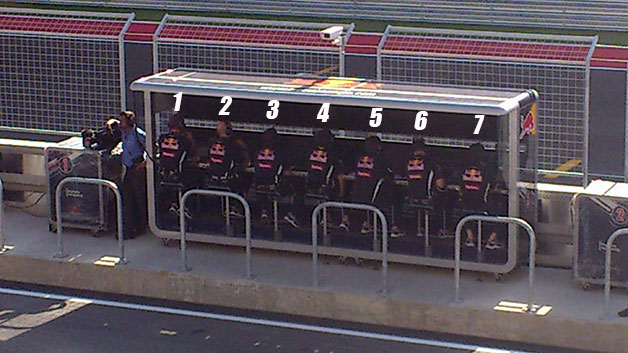
Ever wonder who all those folks are on the pit wall? Here's the Red Bull starting seven:
1. Jonathan Wheatley, team manager, in charge of logistics and getting the team from place to place, as well as having a hand in team strategy during a race
2. Adrian Newey, chief creative officer, monitors how the car is behaving, gets feeds from the garage and from the engineers monitoring data in the UK
3. Christian Horner, team principal, ultimate decision maker
4. Andy Damerum, driver development manager and engineer, handles the F1 simulator at Milton Keynes for all Red Bull drivers and assists with set up
5. Will Courtenay, head of race strategy
6. Guillaume Rocquelin, Sebastian Vettel's race engineer
7. Ciaron Pilbeam, Mark Webber's race engineer
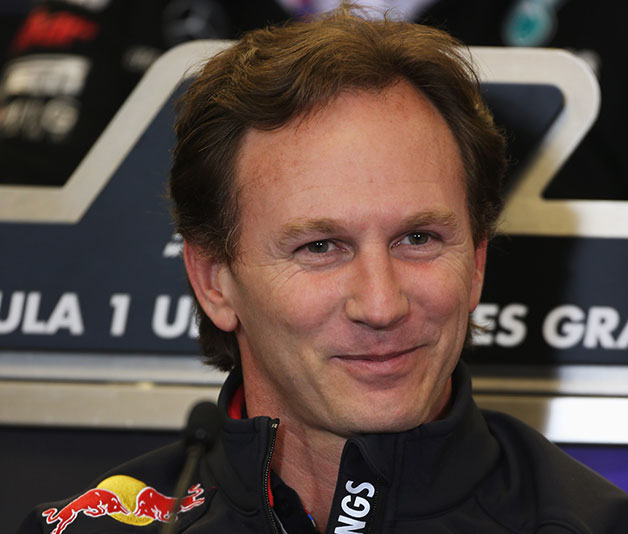
We had a brief one-on-one with Team Principal Christian Horner before the race. Horner started off as a racing driver, making it to Formula 3000 in 1997 and driving for two years before buying the team in 1999. He's the only ex-racer to drive in an upper-tier series except for HRT's Luis Pérez-Sala, and the second-youngest team principal on the grid (he just turned 39 last Friday) after Caterham's new hire, Cyril Abitoye. He still runs the Arden International GP2 team – which finished third in the Constructor's Championship this year.
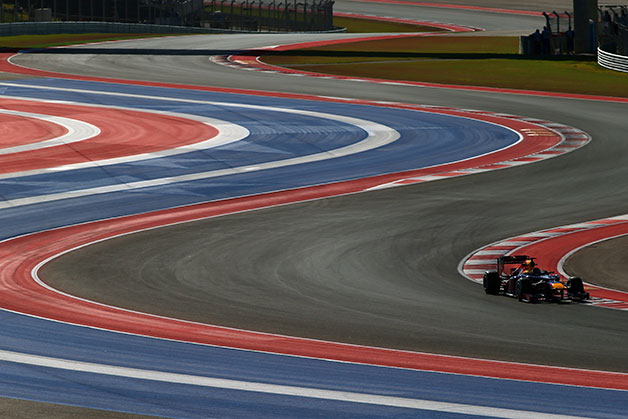
We won't know if the race did well until next year, but there was lots of discussion among colleagues after the race. Compared to American racing series', it's probably not unfair to call Formula One the soccer of motorsport – unless the race is full of apparent excitement like lots of passing or rollercoaster incidents as happened in Abu Dhabi, then knowledge of the sport, the history, the skill the money and the technology involved are requirements to fully appreciate it. One journo, an IndyCar and NASCAR fan watching his first Formula One race, said he found it boring and couldn't understand why the commentators would get excited about somebody getting passed for eighth place. He also thought that the third-placed finisher coming in 37 seconds after the first two threw a big ol' wet rag on proceedings.
Others who know the sport – yours truly included – thought it was a good show, and along with the thrill of the whole weekend, think it made a great start to the return of F1 in the US. But we won't really know how the sport will fare and what kind of struggles it might face until next year, when the people who came only to be at the first race don't (or do) come back. Stories of "media indifference" to the race have already come out, but the idea that F1 can just "come back" to America is misguided; F1 needs to work its way back into America, and that will take more than one race, probably more than four. Absolutely everyone agrees that a second race in New Jersey, not expected until 2014, will greatly help things. Other theories were that if Sergio Perez can rack up some wins in the McLaren before next year's USGP that will bring even more Mexican fans out, and that if the Circuit of the Americas really can attract other big series' over the objections of other Texas racetrack promoters, that will help its chances as well. We'll also add that, as Madincea [below] said of F1 commercial sponsor efforts, F1 needs to make a sustained effort away from the track, and away from race days, to capture American attentions.
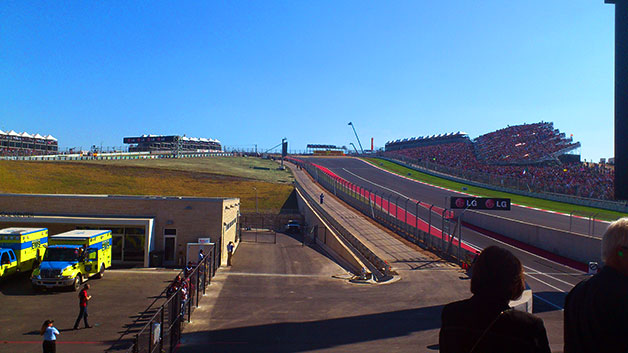
Heaps of big money track-side seats in the main grandstand were empty, and the television cameras naturally avoided the lower decks. We were told that those seats were for the 1,500 or so folks who bought Paddock Club tickets – meaning us, the same folks in the paddock club seats – which we find odd, but we couldn't verify. Other venues will install seats of different colors to make it look like the stands are occupied – the mass of Austin's gray plastic and empty thrones glared back at those of us in the paddock suites. If it was that difficult to sell them this year, Austin organizers will want to get to work right now on a better plan for next year. Even in the paddock suite area we grabbed a prime seat on the Turn One lookout that we were certain would be jam packed. The grandstands and grassy areas around the track, however, were full and buzzing.
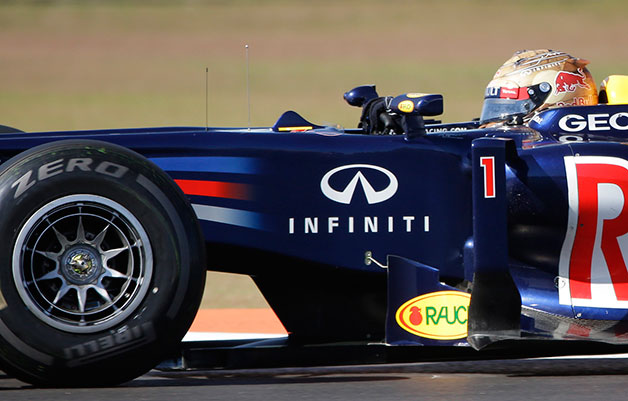
We chatted with Steve Madincea, the principal of one of Infiniti's PR companies who's been in major event marketing, including the Olympics, World Cup and F1, for 30-odd years. He's worked with Benetton, Ford and Michael Schumacher, Shell, Coca-Cola, Samsung and Visa among others. Infiniti gave him the task of approaching Red Bull, and then Sebastian Vettel, to discuss a commercial tie-up.
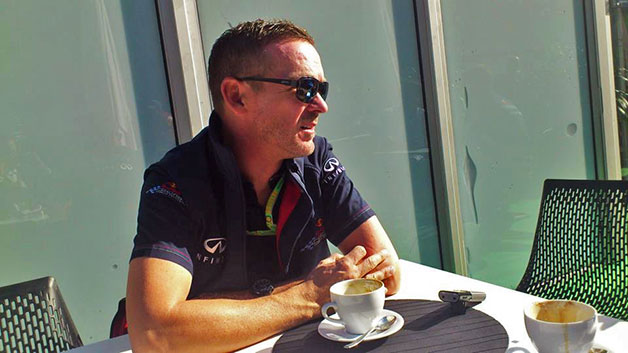
We sat down briefly with Andreas Sigl, an ex-Audi executive who was asked in 2005 "to help a premium Japanese brand go global." (He has since been followed by Johan de Nysschen, former Audi of America CEO who now runs Infiniti from Hong Kong, and Jeff Kuhlman, who ran Audi's North American PR operation but is now in charge of Nissan's global corporate PR in Japan.)
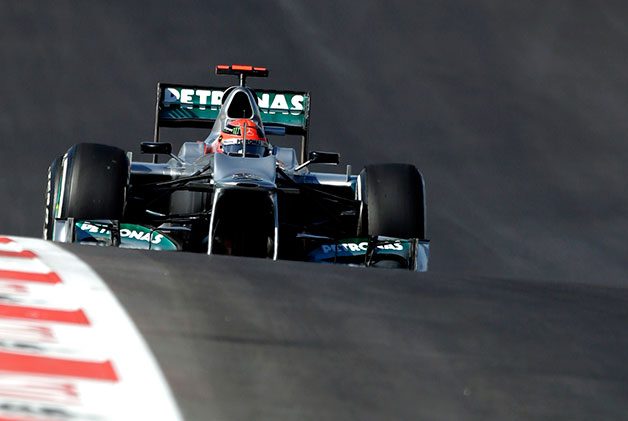
For the last few races Ross Brawn has said that his Mercedes-AMG Petronas team has turned a corner and is on the upswing. Nico Rosberg said after Friday practice in Austin that he rated his chances as "Better than usual." And come Sunday for the last few races we find out the Mercedes W03 is still suffering from the same problems it has had all year, either updates that didn't work as expected or silly blunders or reliability or horrific tire wear. Rosberg opted to use an old exhaust system and qualified 17th but was able to get to 13th by the end of the race. Schumacher did the opposite, outperforming the car to get 6th on the grid then spending the race going in reverse, finishing in 13th. Rosberg hasn't scored a point in five races, Schumacher's gone pointless for six. Is Lewis Hamilton really ready to make a switch to this team?
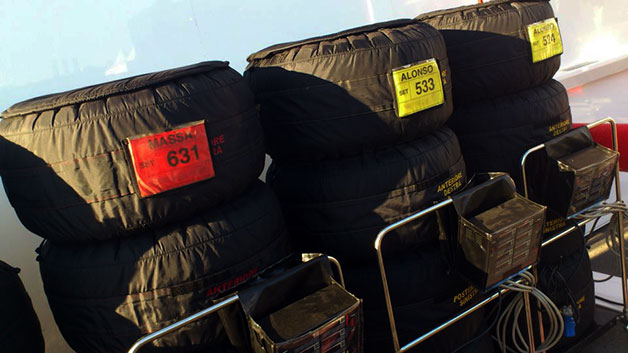
Massa's tires were lined up in front of Alonso's behind the pits on Sunday morning, just like Massa should have lined up in front of Alonso on the grid if not for a Ferrari's switcheroo. By breaking the seal on one of Massa's unused gearboxes (but not actually changing the gearbox on his car), Massa took a five-spot penalty for the good of the team. Coming after a similar penalty for Lotus' Romain Grosjean, it moved Alonso up two places and over to the clean side of the track. The tactic raised more than one eyebrow, but we thought the UK's Sky F1 commentator Martin Brundle summed up the issue best: "There's no such thing as 'the spirit of the regulations.' It's legal."
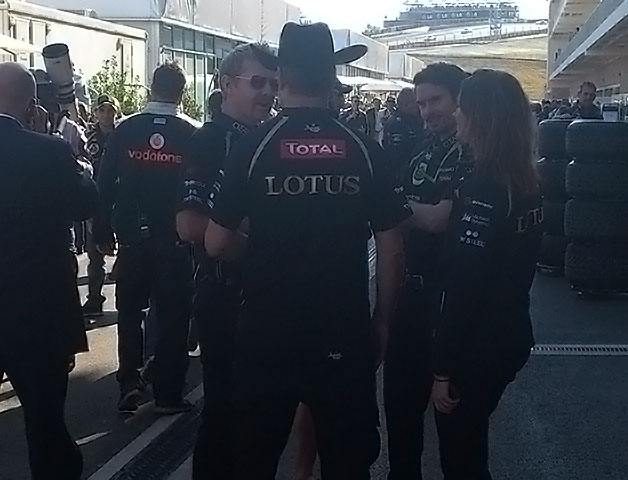
How do you know you're at a race in Texas?
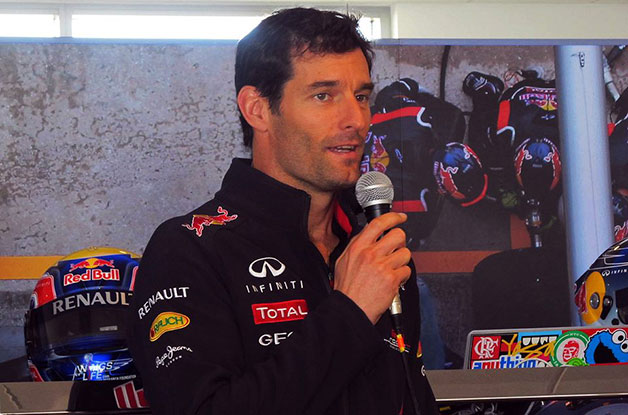
The ever-sanguine Mark Webber stopped by the Red Bull paddock suite before the race. When asked how important it was for F1 to be back in America, the call-it-as-he-sees-it Aussie said, "Well, F1's got a long history, and it's done all right without being in America for this long, so...." He did admit that the US would be a good place for F1 to be popular, he just had to do it his way.
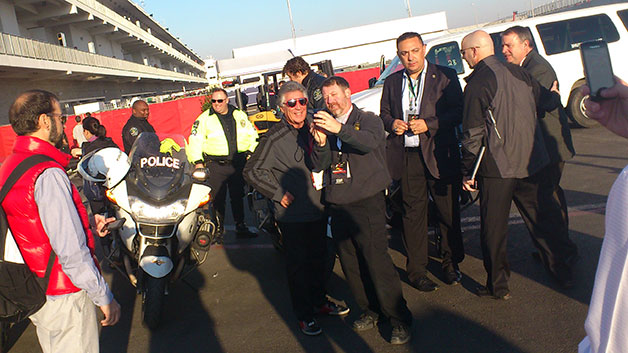
Mario Andretti arrived at the track Sunday morning in a BMW 7 Series, escorted by a black Suburban with flashing lights and five motorcycle policemen. Then he posed with fans and signed autographs. That part was cool. Just never let the man conduct a post-race interview again, or give him a teleprompter, but don't let him have three world champions together during the most thrilling F1 season in years and begin his questions with a 60-second preamble followed by the sole query, "So, what did you think of the track?"
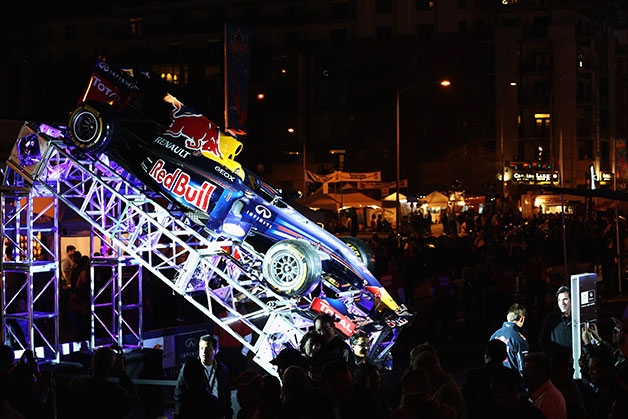
In the Fan Zone in downtown Austin, Red Bull had a mounted chassis, and just behind that was an Infiniti drag race video game that went all the way with the realism: it was two Infiniti G37 IPL Convertibles that had been put on two dynos side-by-side, in front of two giant screens. Challengers sat in the cars to see who could outdrag the other. It was a test of reaction times, really – when the red lights went your job was to floor it and not much else, unless you chose to do your own paddle-shifting – but random members of the public getting to flog cars on dynos for three straight nights in downtown Austin isn't a thing you see too often. Or ever.
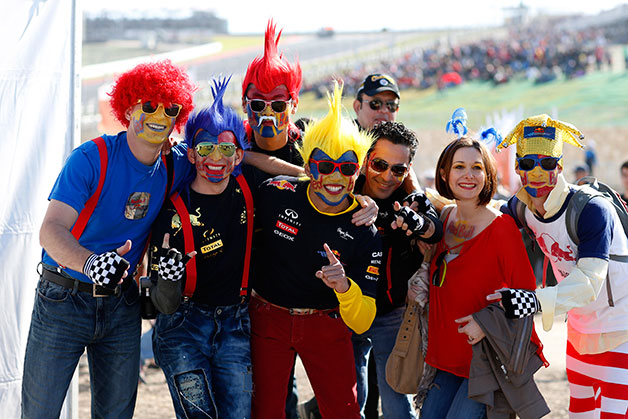
When Lewis Hamilton won, he radioed to his team "That was wicked!" Also wicked, and absolutely, positively, most importantly, is this: Austin did a fabulous job, and a great city put on a great weekend. End of story.

Ever wonder who all those folks are on the pit wall? Here's the Red Bull starting seven:
1. Jonathan Wheatley, team manager, in charge of logistics and getting the team from place to place, as well as having a hand in team strategy during a race
2. Adrian Newey, chief creative officer, monitors how the car is behaving, gets feeds from the garage and from the engineers monitoring data in the UK
3. Christian Horner, team principal, ultimate decision maker
4. Andy Damerum, driver development manager and engineer, handles the F1 simulator at Milton Keynes for all Red Bull drivers and assists with set up
5. Will Courtenay, head of race strategy
6. Guillaume Rocquelin, Sebastian Vettel's race engineer
7. Ciaron Pilbeam, Mark Webber's race engineer

We had a brief one-on-one with Team Principal Christian Horner before the race. Horner started off as a racing driver, making it to Formula 3000 in 1997 and driving for two years before buying the team in 1999. He's the only ex-racer to drive in an upper-tier series except for HRT's Luis Pérez-Sala, and the second-youngest team principal on the grid (he just turned 39 last Friday) after Caterham's new hire, Cyril Abitoye. He still runs the Arden International GP2 team – which finished third in the Constructor's Championship this year.
- On being a Team Principal who's also been a racing driver: "As a driver you only have to think about yourself, but when you're responsible for a whole team it's a totally different pressure. One of the things that helps is that sometimes a driver will talk to his engineer and things can get lost in translation, but I might be able to understand it and say, 'I think he actually meant this.'"
- On the difference between how Red Bull used to be treated when it first came in and how it's treated now: "The other teams don't talk to us now."
- On the collaboration with Infiniti: "We do have limited resources – we have 200 designers at Milton Keynes, Nissan's R&D department has something like 20,000. Other automakers [in the sport] have a head start with technologies like vehicle dynamics and material science, and this partnership provides a much more level playing field for us."
- On his superstitions as a race driver and as a team principal: "As a driver I would always get in from one side of the car, and I'd always put my helmet on before I got in the car. As a team principal, at every circuit I have a lucky toilet." In Austin it wasn't in the Red Bull suite, it was in a trailer up the paddock.

We won't know if the race did well until next year, but there was lots of discussion among colleagues after the race. Compared to American racing series', it's probably not unfair to call Formula One the soccer of motorsport – unless the race is full of apparent excitement like lots of passing or rollercoaster incidents as happened in Abu Dhabi, then knowledge of the sport, the history, the skill the money and the technology involved are requirements to fully appreciate it. One journo, an IndyCar and NASCAR fan watching his first Formula One race, said he found it boring and couldn't understand why the commentators would get excited about somebody getting passed for eighth place. He also thought that the third-placed finisher coming in 37 seconds after the first two threw a big ol' wet rag on proceedings.
Others who know the sport – yours truly included – thought it was a good show, and along with the thrill of the whole weekend, think it made a great start to the return of F1 in the US. But we won't really know how the sport will fare and what kind of struggles it might face until next year, when the people who came only to be at the first race don't (or do) come back. Stories of "media indifference" to the race have already come out, but the idea that F1 can just "come back" to America is misguided; F1 needs to work its way back into America, and that will take more than one race, probably more than four. Absolutely everyone agrees that a second race in New Jersey, not expected until 2014, will greatly help things. Other theories were that if Sergio Perez can rack up some wins in the McLaren before next year's USGP that will bring even more Mexican fans out, and that if the Circuit of the Americas really can attract other big series' over the objections of other Texas racetrack promoters, that will help its chances as well. We'll also add that, as Madincea [below] said of F1 commercial sponsor efforts, F1 needs to make a sustained effort away from the track, and away from race days, to capture American attentions.

Heaps of big money track-side seats in the main grandstand were empty, and the television cameras naturally avoided the lower decks. We were told that those seats were for the 1,500 or so folks who bought Paddock Club tickets – meaning us, the same folks in the paddock club seats – which we find odd, but we couldn't verify. Other venues will install seats of different colors to make it look like the stands are occupied – the mass of Austin's gray plastic and empty thrones glared back at those of us in the paddock suites. If it was that difficult to sell them this year, Austin organizers will want to get to work right now on a better plan for next year. Even in the paddock suite area we grabbed a prime seat on the Turn One lookout that we were certain would be jam packed. The grandstands and grassy areas around the track, however, were full and buzzing.

We chatted with Steve Madincea, the principal of one of Infiniti's PR companies who's been in major event marketing, including the Olympics, World Cup and F1, for 30-odd years. He's worked with Benetton, Ford and Michael Schumacher, Shell, Coca-Cola, Samsung and Visa among others. Infiniti gave him the task of approaching Red Bull, and then Sebastian Vettel, to discuss a commercial tie-up.
- On why Infiniti went with Formula One: When we started, global awareness for Infiniti was miserable. We looked at everything, Olympics, World Cup, Premiere League, and F1 just kept coming up as the most effective and efficient. Effective because it gets to motoring and performance enthusiasts, efficient because it crosses borders easier than a global ad campaign."
- On why it signed up Vettel on top of the deal with Red Bull: There was a big internal debate about this. He's a good guy, but let's face it, he's expensive. But we wanted someone to be a voice out front for what we were trying to do. Perhaps he's younger than our ideal demographic, but he's been great... and in hindsight it's one of the smarter things we did.
- On the changes to marketing with F1 over the past 30 years: in the eighties and nineties, 90 percent of the activation was at or around the track. Now I'd say that's flip-flopped for smarter companies. There's a Fan Zone downtown [in Austin]. Abu Dhabi had an even bigger Fan Zone and concerts every night, and this is a relatively conservative Muslim country. We now reach into the public's world in order to bring them into ours.
- When asked if Vettel had any requests for the partnershhip, Madincea said, "We presented him with the amount of time we were asking for from him, and he said, 'If you cut that time in half, I will have time to win, and that will be better for you.'"

We sat down briefly with Andreas Sigl, an ex-Audi executive who was asked in 2005 "to help a premium Japanese brand go global." (He has since been followed by Johan de Nysschen, former Audi of America CEO who now runs Infiniti from Hong Kong, and Jeff Kuhlman, who ran Audi's North American PR operation but is now in charge of Nissan's global corporate PR in Japan.)
- Infiniti's been in the US since 1989, but the global standard for Infiniti retailers only began in 2005 when the first Infiniti Center opened in Korea. Over time, the same as with other premium brands, there will be a cohesive Infiniti 'look' and 'feel' that will be consistent throughout all the touchpoints, one of the most important being the dealerships.
- On the Red Bull collaboration: "It's about people, process and technology. You can't point to a button on the car and say 'This is from F1,'" but the two parties are exchanging information to make each better. "We took Christian Horner and Adrian Newey into [Nissan's R&D] toolbox and asked 'What interests you?' Our Scratch Shield paint, we didn't think it was something that could help [Red Bull], but they've been testing it for its aero properties and they've used it on the car." And just as Ferrari used to employ Michael Schumacher to finesse its road cars, the next G has already been tested by Sebastian Vettel at Tochigi and Red Bull third driver Sebastian Buemi at the Nurburgring, Sigl saying "The engineers have already responded to their inputs."
- On another potential outlet for the Red Bull partnership: "Like Mercedes has AMG and BMW has M – whether it's called IPL or not, we want to have something in that space," and F1 cachet would help the effort in all kinds of ways.
- Another Infiniti rep had told us that "We can't be about the value proposition. Let [a different Japanese automaker] have that." Asked how Infiniti would be different than the German competition it's after, Sigl said "The Germans make great machines. We want to add a human touch," by which he means bring that idea of detailed Japanese hospitality, omotenashi, "into our brand values – it should come across in the car, in the way you shop and how you're treated, and at our events."
- "The medium-term plan from 2010 to 2016 is to bring the business to a whole new level, [working on] different product, retail network and the brand, including diesels, the smaller engines being made with Mercedes-Benz, hybrids and electric cars."
- On the future of the Infiniti-Red Bull partnership: "We're going longer and deeper."
- On how long he thinks it will take for Infiniti to get where he envisions: "I think it will take a long time – in terms of product alone, five to ten years, then you've got architecture and point-of-sale [i.e., the Infiniti Centers replacing old dealership facilities]." His analogy for the effort: "Ask a man what he does, he'll say he's a bricklayer, ask another man, he'll say he's building a cathedral – but they're both doing the same job. We're building a cathedral."

For the last few races Ross Brawn has said that his Mercedes-AMG Petronas team has turned a corner and is on the upswing. Nico Rosberg said after Friday practice in Austin that he rated his chances as "Better than usual." And come Sunday for the last few races we find out the Mercedes W03 is still suffering from the same problems it has had all year, either updates that didn't work as expected or silly blunders or reliability or horrific tire wear. Rosberg opted to use an old exhaust system and qualified 17th but was able to get to 13th by the end of the race. Schumacher did the opposite, outperforming the car to get 6th on the grid then spending the race going in reverse, finishing in 13th. Rosberg hasn't scored a point in five races, Schumacher's gone pointless for six. Is Lewis Hamilton really ready to make a switch to this team?

Massa's tires were lined up in front of Alonso's behind the pits on Sunday morning, just like Massa should have lined up in front of Alonso on the grid if not for a Ferrari's switcheroo. By breaking the seal on one of Massa's unused gearboxes (but not actually changing the gearbox on his car), Massa took a five-spot penalty for the good of the team. Coming after a similar penalty for Lotus' Romain Grosjean, it moved Alonso up two places and over to the clean side of the track. The tactic raised more than one eyebrow, but we thought the UK's Sky F1 commentator Martin Brundle summed up the issue best: "There's no such thing as 'the spirit of the regulations.' It's legal."

How do you know you're at a race in Texas?

The ever-sanguine Mark Webber stopped by the Red Bull paddock suite before the race. When asked how important it was for F1 to be back in America, the call-it-as-he-sees-it Aussie said, "Well, F1's got a long history, and it's done all right without being in America for this long, so...." He did admit that the US would be a good place for F1 to be popular, he just had to do it his way.

Mario Andretti arrived at the track Sunday morning in a BMW 7 Series, escorted by a black Suburban with flashing lights and five motorcycle policemen. Then he posed with fans and signed autographs. That part was cool. Just never let the man conduct a post-race interview again, or give him a teleprompter, but don't let him have three world champions together during the most thrilling F1 season in years and begin his questions with a 60-second preamble followed by the sole query, "So, what did you think of the track?"

In the Fan Zone in downtown Austin, Red Bull had a mounted chassis, and just behind that was an Infiniti drag race video game that went all the way with the realism: it was two Infiniti G37 IPL Convertibles that had been put on two dynos side-by-side, in front of two giant screens. Challengers sat in the cars to see who could outdrag the other. It was a test of reaction times, really – when the red lights went your job was to floor it and not much else, unless you chose to do your own paddle-shifting – but random members of the public getting to flog cars on dynos for three straight nights in downtown Austin isn't a thing you see too often. Or ever.

When Lewis Hamilton won, he radioed to his team "That was wicked!" Also wicked, and absolutely, positively, most importantly, is this: Austin did a fabulous job, and a great city put on a great weekend. End of story.

Sign in to post
Please sign in to leave a comment.
Continue